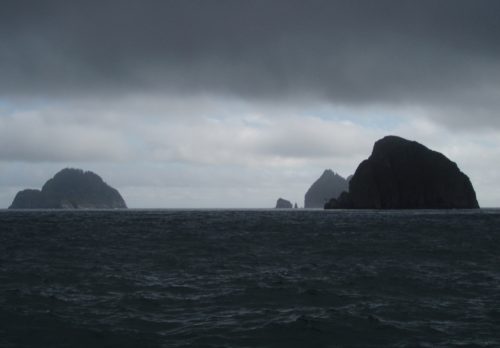New tool factors effects of fossil-fuel emissions on ocean research
May 20, 2021
Jeff Richardson
907-474-6284

A newly developed tool will allow scientists to better gauge how centuries of fossil fuel emissions could be skewing the data they collect from marine environments.
Researchers at the University of Alaska Fairbanks led the effort, which created a way for marine scientists to factor into their results the vast amounts of anthropogenic carbon dioxide that are being absorbed by oceans. Those human-caused carbon sources can muddy research results — a problem known as the Suess effect — leading to flawed conclusions about the health and productivity of marine ecosystems.
“The baseline carbon signature looks different than it did before the Industrial Revolution,” said Casey Clark, a former UAF postdoctoral researcher who led the effort. “People have known this for a while, but there hasn’t been a consistent way to correct for a potential bias in the data.”
The formula allows scientists to factor in the Suess effect in regions that include the Bering Sea, Aleutian Islands and Gulf of Alaska. But the publicly available app will also allow researchers to introduce data from other marine ecosystems, making it potentially useful for scientists around the world.
A paper introducing the new tool was published on May 20 in the journal Methods in Ecology and Evolution.
The new tool will be used for stable isotope analysis, which has become valuable in recent decades for studying plants and animals. The ratio of isotopes in animal tissues gives them a distinct chemical signature, providing a remarkably accurate picture of what those species consumed and where they lived.
But carbon, a primary focus of isotope analysis, has proven more difficult to rely upon as humans introduce more of the element into the atmosphere and oceans.
“Not only are we shifting the global climate, we’ve changed the baseline of what type of carbon is out there,” said Nicole Misarti, the director of UAF’s Water and Environmental Research Center and a co-author of the paper.
Researchers who work with ancient specimens, such as archaeologists and paleontologists, can have their results especially skewed by fossil fuel emissions when making comparisons to modern times. However, the new study shows that even researchers who want to compare today’s data to information collected as recently as eight years ago need to correct for the Suess effect.
“What we did is develop a tool that will let people adapt for those changes,” Misarti said. “It disentangles that human impact from other ecosystem changes.”
Franz Mueter, a professor at UAF’s College of Fisheries and Ocean Sciences, also contributed to the paper. Other authors include Mark Shapley, University of Minnesota; Bruce Finney, Idaho State University; and Mattias Cape, a former postdoctoral researcher at the University of Washington.
ADDITIONAL CONTACTS: Casey Clark, 831-239-5482, ctclark@alaska.edu; Nicole Misarti, 907-474-5457, nmisarti@alaska.edu
NOTE TO EDITORS: The full Methods in Ecology and Evolution paper is available at http://bit.ly/UAFSuessPaper.


